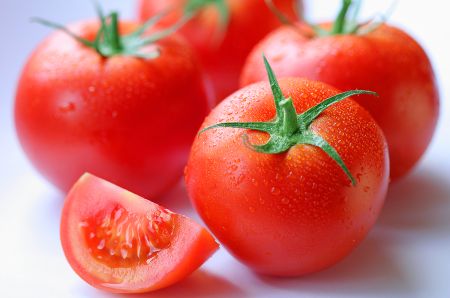A research study linked high blood levels of lycopene – the carotene responsible for the red color in tomatoes- with a 60% reduced risk of stroke and lowered blood cholesterol levels. What foods are rich in lycopene and how much should you eat to keep you out of harm’s way?
A new observational study recently published in the journal Neurology points at a significant relationship between blood lycopene levels and reduced risk of stroke.
The study was conducted in Finland, with over 1,000 men between the ages of 46-65 participating.
The study examined the connection between different blood levels of carotenoids and vitamin E and the risk of having a stroke. The researchers followed the subjects for 12 years, during which 67 strokes were recorded among participants.

After confounding variables such as age, cholesterol levels, diabetes, etc. were eliminated, it was revealed that the men with the highest blood lycopene levels had a 59% lower chance of ischemic stroke (due to vascular obstruction) and a 55% lower chance of having any type of a stroke. This was in comparison to subjects who had the lowest blood levels of lycopene. The other nutritional components examined during the study were not found to be related with the chance of having a stroke.
Lycopene delays the body’s production of cholesterol
Lycopene is one of the most active antioxidants. Research has demonstrated its contribution in reducing oxidation of low-density lipoprotein (LDL) – the “bad cholesterol”. Oxidized LDL has been found to contribute to accelerated atherosclerosis more than high total cholesterol levels. Additionally, lycopene has been observed to contribute to reduced inflammation, delayed production of cholesterol, improved immune function, prevention of platelet adherence, and reduced risk of stroke.
Lycopene may also assist in reducing the risk of certain types of cancer, such as prostate cancer, and it can also help protect the skin against damage caused by sun overexposure. Tomatoes and their products are the main sources of lycopene in the western diet (about 80%). Other sources include watermelon, pink grapefruit, guava, and papaya.
Lycopene is fat-soluble, so to increase its absorption by the body, it is recommended to consume sources along with a small amount of oil or food containing fat, such as olive oil, cheese, nuts, etc.
It is highly recommended to consume fruits and vegetables from all color groups: red, orange, green, white and purple
The many components found in every fruit and vegetable – known as phytochemicals – work in synergy to protect the body from developing diseases. Therefore, it is best to increase the consumption of fruits and vegetables rich in antioxidants, instead of taking individual supplements, which may actual disrupt the natural balance of antioxidants.
Lycopene content in selected foods (per 100 g)*
Tomato sauce – 29 mg
Canned crushed tomatoes – 5 mg
Watermelon – 4.5 mg
Cooked tomatoes – 3 mg
Fresh red tomatoes – 2.6 mg
Fresh papaya – 1.8 mg
Pink grapefruit – 1.4 mg
Get more great health tips for weight loss by clicking here.
*Source: USDA database
Above article: Karppi J, Laukkanen JA, Sivenius J, Ronkainen K, Kurl S. Serum lycopene decreases the risk of stroke in men: a population-based follow-up study. Neurology. 2012 Oct 9;79(15):1540-7.




Thank you Lynn H. for posting what miso broth is and where to find it.
Hi, Lori19. The following is a simply recipe for flavorful fresh tomato juice:
What you need
3 lbs / 1½ kg very ripe tomatoes, cored, chopped
1¼ cups celery with leaves, chopped
⅓ cup white onion, chopped
2 Tbsp organic whole cane juice, or to taste
Salt or substitute to taste
Ground black pepper to taste
Tabasco sauce to taste
What you need to do
Put all ingredients into a large pot, preferably use stainless steel or iron. Bring to a simmer and cook, uncovered, until mixture is completely soupy, about 25 minutes.
Force mixture through a sieve or cheese cloth. Allow to cool completely.
Store covered and chilled. Will last for about 1 week in the refrigerator.
Per Serving: 1 Carb, 0 Protein, 0 Fat
Preparation Time: 5 minutes + cooling time
Cooking Time: 25 minutes
Difficulty: 1
Serving Size: 1 cup / 240 ml
Serves: 4
Would you like to share your recipe with us ??
I have the best recipe for tomato sauce!
Love tomatoes! Love the info! Doesn’t hurt that my favourite colour is red!
Great Information!
Good information. Does anyone out there have a receipe for fresh tomatoe juice.?
Miso Broth is available in Natural Food Stores or Asian grocery stores and is a paste made from fermented soya beans. Also used for making stock. Very nutricious and high Vitamin B content I believe.
In winter we buy the little grape tomatoes. We have a salad most suppers. If they start to shrivel, I just slice them in half and put a vinegar and oil combo on them in a dish. Toss in a little Italian seasoning. They last a few more days and we use them to top salads or just eat as is.
what is miso broth in the tomato soup/ mocktail recipe
Very interesting. Makes me want to eat some tomato sauce tomorrow!!